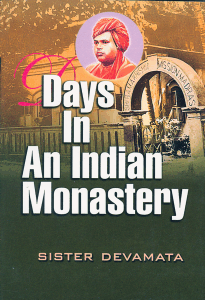“Days in an Indian Monastery” by Sister Devamata
 Although the title, “Days in an Indian Monastery,” nicely conveys the spiritual dignity of the book, it does not do justice to the expanse of treasures tucked within. As an American Ramakrishna nun, Sister Devamata had the gift of spending two years (1909 -11) in the company of Sri Ramakrishna’s direct disciples, especially, Swami Ramakrishnananda, whom she served directly. She reverently shares many teachings which were bestowed on her, such as the one given by him on meditation, “…. complete annihilation of self-consciousness …before the effulgent glory of God, the little glory of the ego will completely vanish…” What is even more compelling is that she was intimately acquainted with Sri Sarada, herself, and witnessed the “transforming power” of Sri Ramakrishna even though he was no longer on the earthly plane.
Although the title, “Days in an Indian Monastery,” nicely conveys the spiritual dignity of the book, it does not do justice to the expanse of treasures tucked within. As an American Ramakrishna nun, Sister Devamata had the gift of spending two years (1909 -11) in the company of Sri Ramakrishna’s direct disciples, especially, Swami Ramakrishnananda, whom she served directly. She reverently shares many teachings which were bestowed on her, such as the one given by him on meditation, “…. complete annihilation of self-consciousness …before the effulgent glory of God, the little glory of the ego will completely vanish…” What is even more compelling is that she was intimately acquainted with Sri Sarada, herself, and witnessed the “transforming power” of Sri Ramakrishna even though he was no longer on the earthly plane.
Throughout the chapters, she reveals rare and abundant insights into the character and wisdom of these cherished ones. For example, “Those who had the rare blessing of living with Holy Mother learned that religion was a sweet, natural, joyous thing, that purity and holiness were tangible realities,” or when Swami Ramakrishnananda was asked if Sri Ramakrishna appeared mad, he replied, “…not at all, he was most careful in his speech and manner. Compared to him we are all boors. Even when he would sit and talk to his Divine Mother…he was satisfying the needs of each of those hearts and lifting their burdens.” There are also gentle reminders of their human side, such as when Swami Brahmananda had her buy a Scrabble type game so the younger monks could improve their English or Holy Mother’s delight in a “Jack in the Box” toy. We are privy to her own poignant spiritual experiences such as her first visit to Dakshineswar where “…overall there floats a ‘Holy Presence’ (of Sri Ramakrishna); it permeates like a lingering fragrance, enveloping worship and worshippers with the peace of a benediction.”
In addition to these spiritual highlights, she also covers more worldly concerns such as the household, society, education and the like, but for those of us who love Mother India, even these should not fail to delight or appear frivolous. In one description, she reveals the theme that pervades her eloquent writing: “The temple glowed a deep pink, dyed by the rays of setting sun, the dwelling houses ….were in grey shadow. It seemed to tell the story of India, the real India, the highlight always on the religious aspect of life.” This is well demonstrated by the anecdotes of the more humble devotees such as the man who walked 100 miles to attend a religious festival every year. Nor are these glimpses limited to the early 20th century, but as stated in the preface by Gayatri Devi: “To see today’s India (1975) through our Sister’s eyes is to witness what the Upanishads call ‘the Eternal among the changing.'”
